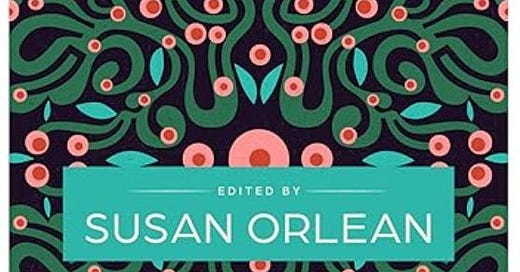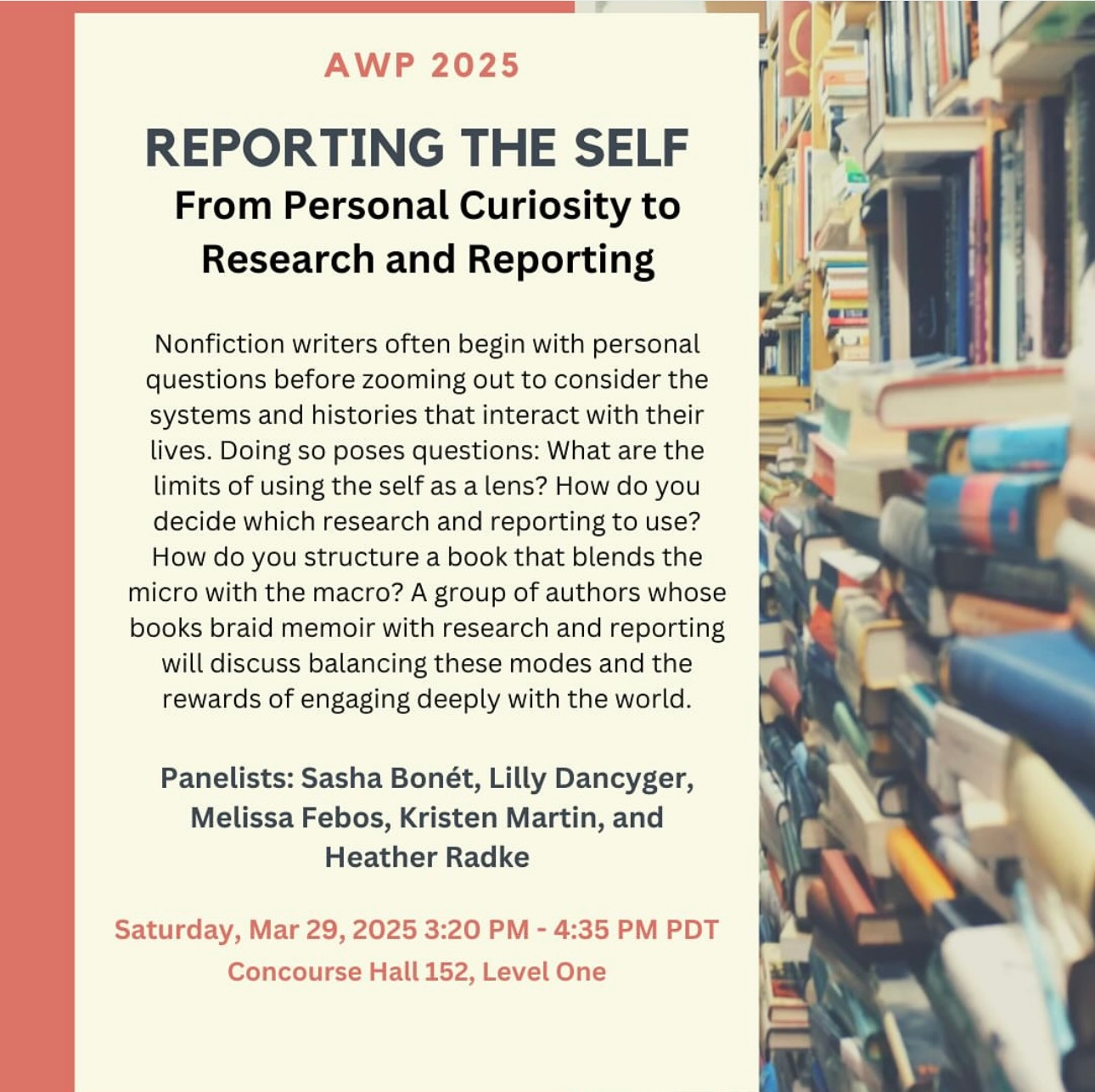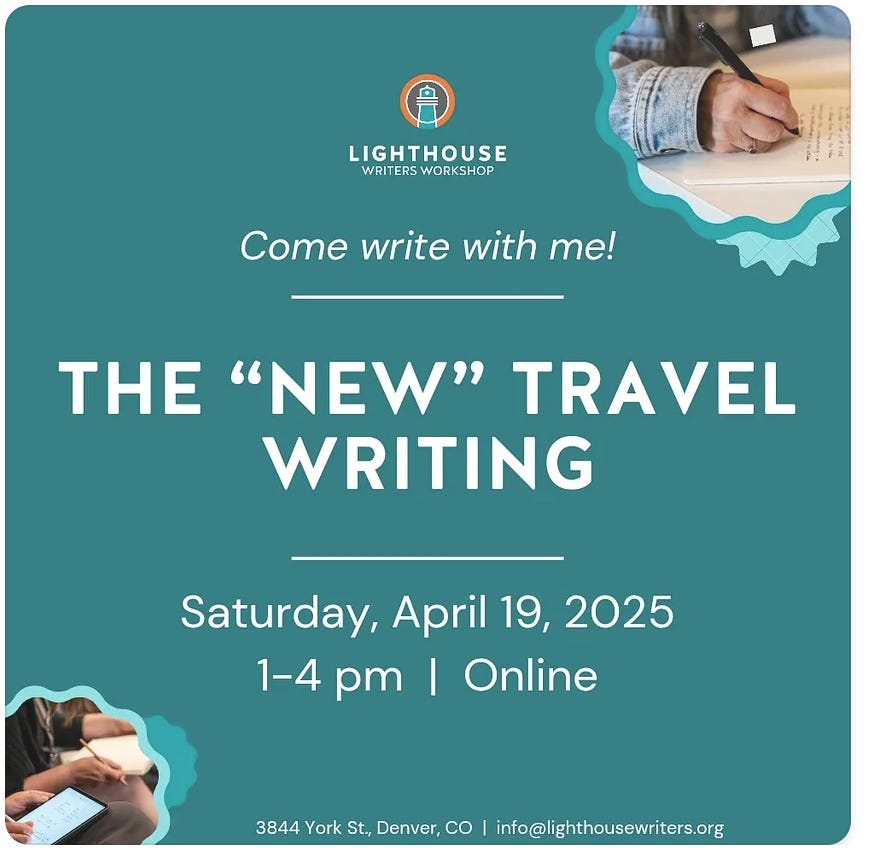I know many of you are at the Association of Writers & Writing Programs conference in Los Angeles this weekend. I am actually away at a much-needed writing retreat, but I keep seeing so many great panels pop up and I wanted to share this one in particular if you will be at AWP. It’s all about “reporting the self,” featuring Melissa Febos, Heather Radke, Lilly Dancyger, Sasha Bonét, and
, who recently published The Sun Won’t Come Out Tomorrow, an important book that upends the myth of the orphan and interrogates the real history of orphanhood in society, combining analysis and personal reflection.Meanwhile, if you are instead looking for online opportunities,
is teaching this online course on travel writing, “The ‘New’ Travel Writing,” Saturday, April 19th, exploring how to avoid the risks of parachute journalism, and practice compassionate, non-exploitative travel reporting.More Resources to Read, Listen, or Learn
I admire when journalists turn their reporter’s eye to details and moments of their own lives, and this personal essay about getting your hair “done” is such a lovely example. The piece expands into a story about a mom who had a frontal lobotomy, the daughter in her shadows, and what generations of hair styling means to women. It is published by
, a longtime magazine journalist and author, in ’s well-read Substack, Oldster magazine.This week, I also enjoyed this conversation from Jordan Kisner’s “Thresholds” podcast with Sabrina Imbler, author of How Far the Light Reaches, who talked about working at major legacy newspapers before joining Defector, a worker-owned media company, which made them rethink their approach to integrating personal writing with science reporting.
I found this interview by Emma Leokadia Walkiewicz of
with fiction writer Natasha Brown so interesting. Narrative nonfiction has long “borrowed” from the techniques of fiction. What happens when a novelist borrows from narrative nonfiction style? Brown’s new book, Universality, centers on a freelancer and what happens after her story goes viral. As part of the book marketing, Brown even constructed an online excerpt that “spoofs” longform reading, down to the blurred bottom of a story as it cuts off.Elsewhere on Substack,
of Wild Writing has put together an incredible list of deadlines for nonfiction writers. And of Your First Byline posted “The Three Things You Need for a Great Magazine Article,” with advice from Vanity Fair editor Graydon Carter. I also appreciated this piece: “How writers can move up and down the ladder of abstraction,” on capturing concrete details & universal themes in your writing, by .A New Podcast by Nieman Storyboard
Today, Mark Armstrong, editor of the Nieman Storyboard, launches a new podcast for in-depth conversations about the craft of journalism and storytelling, presented by the Nieman Foundation for Journalism at Harvard. Hosted by Armstrong, who has been producing great podcasts in recent years at Ursa Story Company, the show will delve into longform narratives and books, podcasting, documentaries, and social media. It will feature journalists, writers, and producers talking about how they do the work. I am deeply honored to be the first journalist interviewed by Armstrong for this new podcast.
Nieman Storyboard previously featured a behind-the-scenes look at one of my New York Times stories: “She Survived the Maui Wildfire. She couldn’t Survive the Year After,” in a craft interview and story dissection by Kim Cross. This week,
of Longform Profiles also published a new Q&A which goes into more of my reporting for the Times story. That piece is centered on a woman I got to know, Edralina Diezon.For the Storyboard podcast, which is available on Apple Podcasts and Spotify, Armstrong and I talked about trauma-informed reporting, focusing on another piece I published after the wildfires, “Maui on Fire,” for New York Magazine & The Cut.
Speaking of which, I am also thrilled to announce that “Maui on Fire” was recently selected by one of my favorite feature writers,
, to be anthologized in the Best American Science and Nature Writing 2025 book series.Being recognized for these stories in any way is humbling and heartening, especially when I remember how many rejections I received trying to write about Maui wildfire survivors. I discovered the Best American series when I first became a journalist, and always looked to its nonfiction stories as a model for the kind of writing I aspired to do. I have also long admired Orlean, studying her books such as The Bullfighter Checks Her Makeup, an anthology of her New Yorker pieces, and assigning her book The Orchid Thief to students. Having my story picked by Orlean just makes this honor extra special to me.
So, thank you to Armstrong, Cross, Nguyen, Jaime Green, the series editor for The Best American Science and Nature Writing, and, of course, to Orlean.
Next week, I will be back with a Q&A with Rebecca Tuhus-Dubrow, who has a new nonfiction book coming out on April 8th, Atomic Dreams. The book is “the inside story of how nuclear energy has become the hot topic of the climate debate...and perhaps a vital power source of the future.” Tuhus-Dubrow talks about the scary parts of starting to embark upon narrative storytelling, and going from New Yorker article to book.
Have a great weekend.
—Erika









There’s something quietly restorative about this.
A podcast that resists the pressure to explain everything, fix everything, win the conversation—it feels like a breath. Like making space for story as a way of being, not just content.
The tone here carries care. And in a world of hot takes and fast scrolls, that kind of slow attention feels almost radical. Looking forward to sitting with these stories, not just hearing them.
So happy that Nieman Storyboard has launched a podcast with Mark Armstrong at the helm, and a smart move on his part interviewing you for the debut episode!